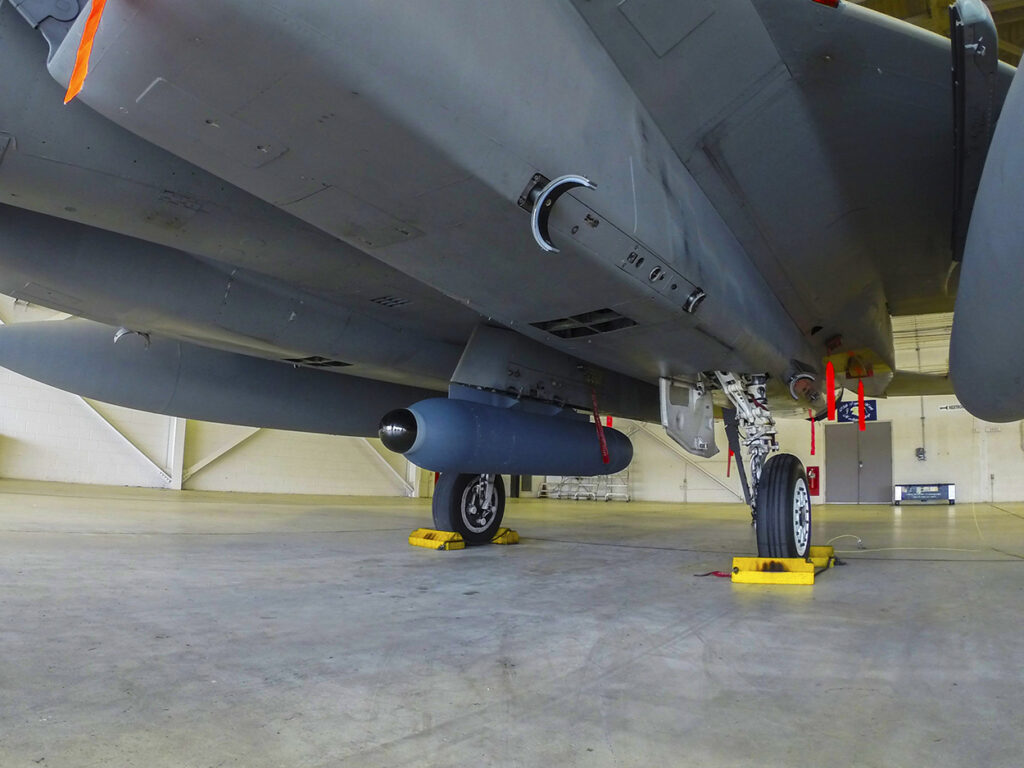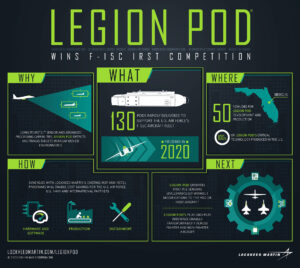
Lockheed Martin’s Legion Pod IRST system
WASHINGTON: The Air Force is a step closer to fielding the Legion Pod infra-red search and track (IRST) system on its F-15 and F-16 fleets — a passive sensor that gives pilots a long-range ability to track stealthy aircraft without giving away their own presence.
The Lockheed Martin-built IRST system just passed two major testing milestones: the first shot of an AIM-9X air-to-air missile from an F-15C Eagle using the Legion Pod for targeting; and the first flight of an operational F-16 Fighting Falcon with the Legion Pod, Air Combat Command announced Tuesday in a press release.
“This is exceptionally important, as the Legion Pod uses an advanced IRST technology that gives 4th generation fighters the ability to ‘see’ stealth aircraft that traditional radar cannot,” an Air Combat Command spokesperson says in an email.
Because it uses infrared to track an airplane’s heat signature, the system isn’t affected by radar jamming. Further, IRST systems are passive, meaning the Legion Pod can act without emitting any radiation of its own that might allow an enemy to recognize they are being targeted.
 The Air Force is driving toward initial operational capability (IOC) for the Legion Pod by the end of the year, under a rapid testing program managed by the Operational Flight Program Combined Test Force (OFP CTF). The unit is unique in that it reports both to Air Combat Command and Air Materiel Command, and is empowered to do developmental and operational testing at the same time — unlike traditional sequential testing programs.
The Air Force is driving toward initial operational capability (IOC) for the Legion Pod by the end of the year, under a rapid testing program managed by the Operational Flight Program Combined Test Force (OFP CTF). The unit is unique in that it reports both to Air Combat Command and Air Materiel Command, and is empowered to do developmental and operational testing at the same time — unlike traditional sequential testing programs.
“The OFP CTF’s work on the Legion Pod is done differently than the traditional acquisitions method,” Lt. Col. Thomas Moser, the unit’s commander, says in the press release. “We actually started testing the pod in a Pre-Developmental Test (DT) phase in early 2019 and got it to an eighty percent solution before it ever entered the official developmental phase. This ultimately allowed us to go through the developmental and operational testing quicker. What would normally take several years has been reduced to eighteen months from the start of DT to expected fielding.”
The Air Force selected the Legion Pod to equip the F-15C fleet in 2017; and Lockheed Martin received a contract for the system from prime contractor Boeing in 2018 for development and low-rate initial production of 19 pods.
“Currently, we are under contract for 38 LRIP systems,” Lockheed Martin spokesperson Dana Edwards Szigeti tells Breaking D in an email. “The next generation Block II systems are also under development with the U.S. Navy and we look to transition that to Legion Pod for the U.S. AF and Air National Guard over the next few years. Block II significantly increases system performance.”
The new F-15EX jets also will be compatible with the pod, according to Boeing’s program manager Prat Kumar — although there isn’t a formal contract yet.
The system is based on Lockheed Martin’s IRST21 sensor, also being used by the Navy in its Block III F/A-18E/F Super Hornet fleet.
In addition, Lockheed in May received an indefinite delivery/indefinite quantity (ID/IQ) contract, worth up to $485 million, that will allow the US military services and allies to buy the IRT21 sensor, as well as other sensor products such as the Sniper Advanced Targeting Pod and the LANTIRN Extended Range pod, for five years at pre-set price points. That contract vehicle will allow the Air Force to equip the F-16 fleet with the Legion Pod, Edwards Szigeti said.
In a ‘world first,’ DARPA project demonstrates AI dogfighting in real jet
“The potential for machine learning in aviation, whether military or civil, is enormous,” said Air Force Col. James Valpiani. “And these fundamental questions of how do we do it, how do we do it safely, how do we train them, are the questions that we are trying to get after.”


























